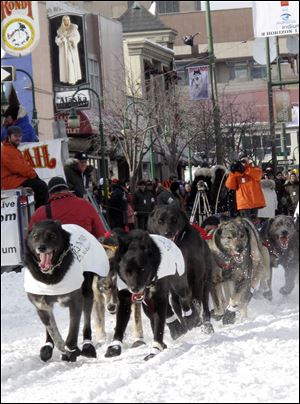
62 Iditarod dog teams begin 1,150-mile sled race
3/7/2011
Veteran musher John Baker dashes along 4th Avenue in Anchorage, Alaska, on Saturday during the traditional ceremonial start of the Iditarod race.
The restart was held in the town of Willow, north of Anchorage, where 62 teams took off on the Iditarod Trail across a frozen lake marking the competitive portion of the 1,150-mile race.
The racers also left behind the party-like atmosphere that surrounded Saturday's ceremonial start in downtown Anchorage. The restart is a more businesslike affair as mushers say goodbye to family and loved ones and turn their attention to the world's longest sled dog race.
Some of them want more than just to finish the race. They want to oust defending champion Lance Mackey, who has dominated the Iditarod with four consecutive victories.
Mackey, 40, says he's hungry for a fifth and has the dog team to do it.
"Whoever takes the title from me will have to earn it," he said yesterday. "I'm good to go."
Race officials have described this year's Iditarod field as especially competitive, consisting of nine of the top 10 teams. Four-time Iditarod champion Jeff King retired after last year's race when he finished third.
The trail has good snow cover and is one of the best in recent memory, perhaps promising a fast race. If it is, the winner could cross the finish line in eight days or less.
The top 30 finishers will share a purse of $528,000. The winner will get $50,400 and a new truck. The payout for the others is reduced somewhat this year, ranging from $46,300 to $1,500.
Mackey, who finished the 2010 race in eight days, 23 hours, 59 minutes -- the second-fastest finish in Iditarod history -- acknowledges he doesn't need a new truck, but he wants one anyway.
However, what he really wants is to get every one of his 16 dogs in his team to the finish.
"They are pretty amazing animals," Mackey said.
The Iditarod began in 1973 to commemorate a race against time, when sled dogs and drivers teamed up in 1925 to defeat a deadly outbreak of diphtheria in Nome.
It was feared the disease would decimate Eskimo families living near the gold-rush town on Alaska's western coastline.
Dog drivers drove teams 674 miles from Nenana to Nome to deliver the lifesaving serum in five days.
Mitch Seavey, the 2004 champion, said while Mackey has done an outstanding job it is important that he gets a second Iditarod win. This year he has the team to do it too.
"As good as Lance Mackey is and as successful as he is, he is not the only one who is a champion and can win this year," Seavey said.
"I have a dog team that I think can do anything I ask them to do."